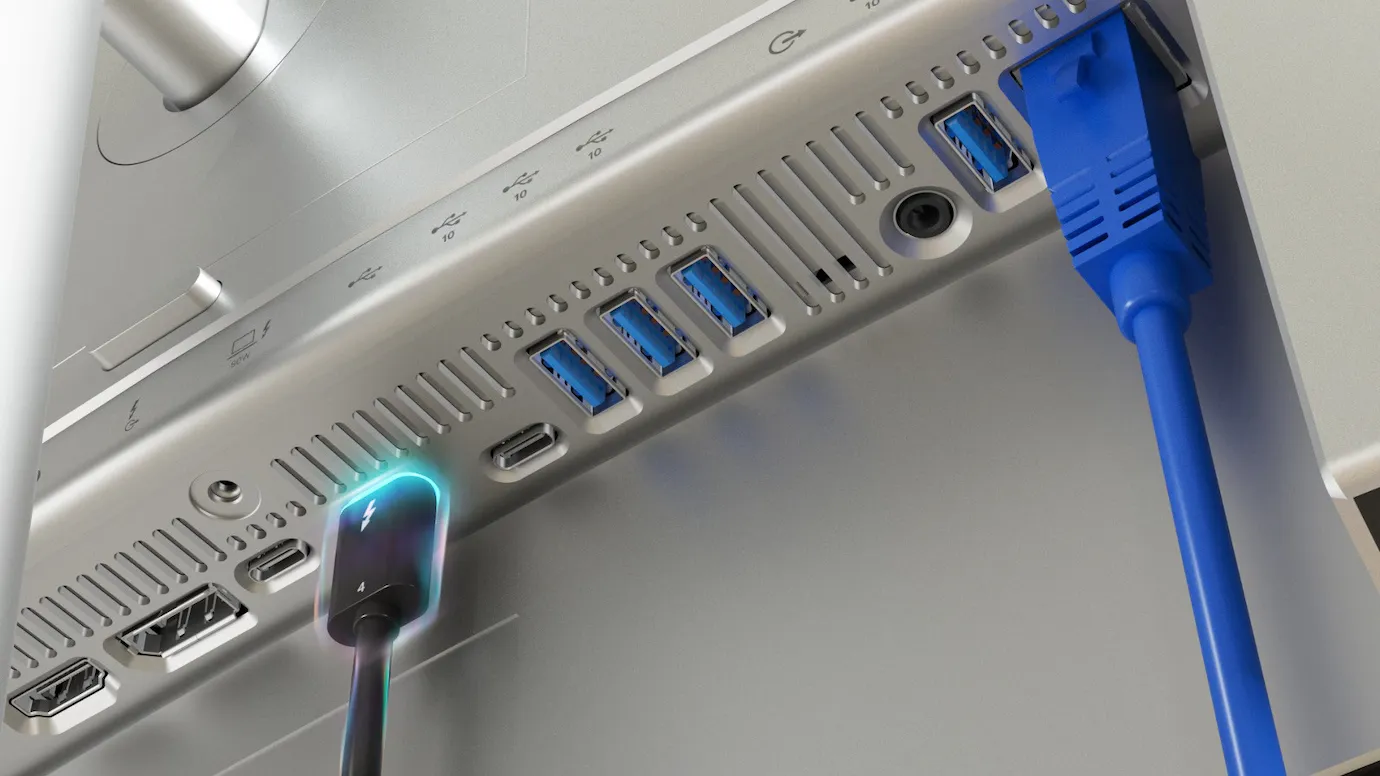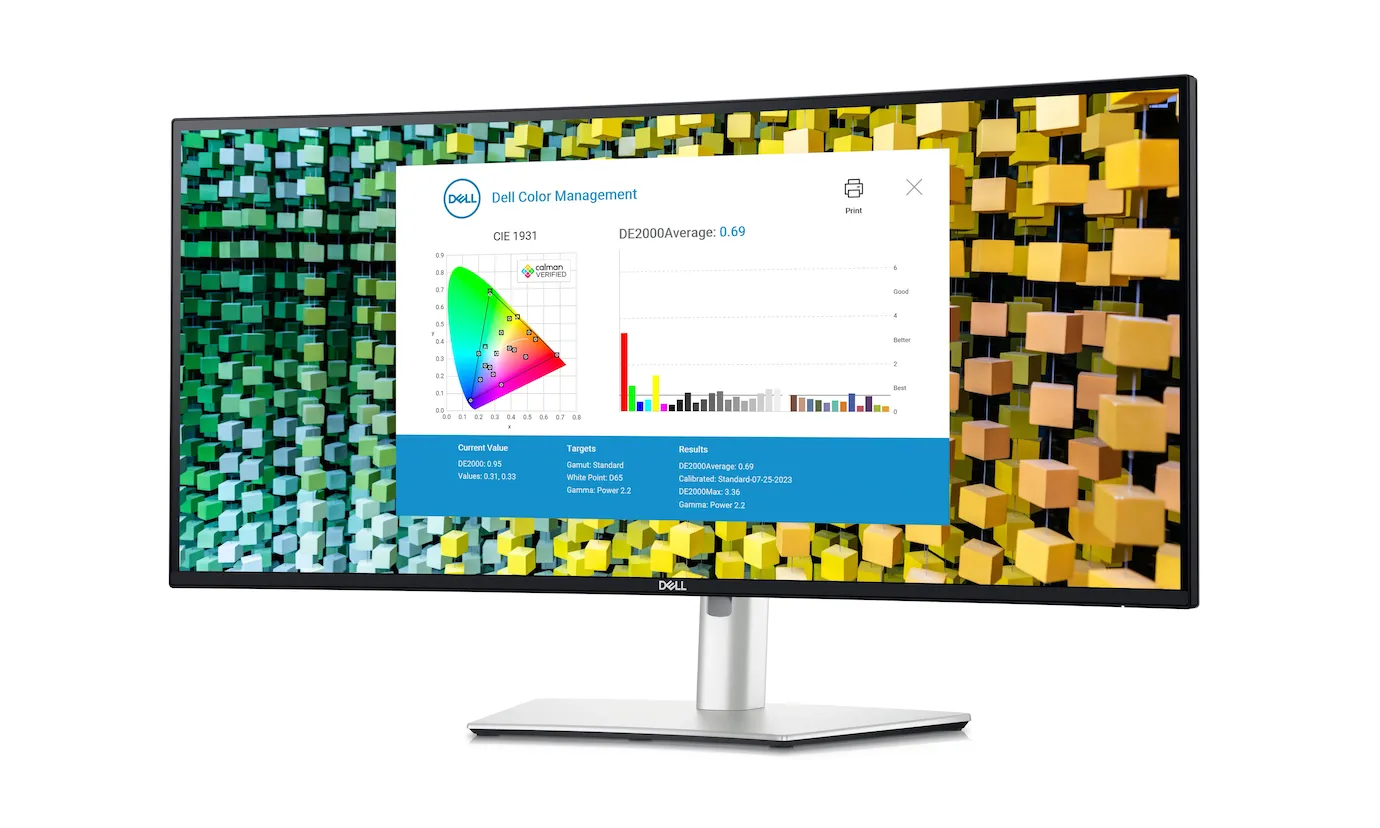



















£744.98*
Prices incl. VAT.
3-5 working days In stock. Ready for immediate dispatch. Delivery Time 3-5 working days
Shipping from £8.99 Product number: 1000033307
- Resolution 3440 x 1440 UWQHD
- Diagonal 34"
- Refresh Rate 120Hz
- Aspect Ratio 21:9
A G
F Energy efficiency class



visunext Services
Product information
Immerse yourself in a detailed picture and smooth movements: The ultra-wide, curved Dell WQHD monitor with 120 Hzensures relaxed working and precise colours. Designed for professionals who value ergonomics and impressive image quality.
The technical highlights at a glance:
- 34-inch WQHD monitor (86.36 cm) with 5-star "Eye Comfort" certification
- Refresh rate of 120 Hz for flicker-free, smooth display
- IPS Black Panel for richer blacks with a contrast ratio of 2.000:1
- 98% DCI-P3 and Display P3 colour coverage
- Environmental light sensor for automatic brightness and colour temperature adjustment
- Thunderbolt™ 4 with 90 W Power Delivery
- RJ45 port for Ethernet up to 2,5 GbE
- Internal Multi-Stream Transport (iMST) for dual monitor functionality
- Dell colour management software with Calman Verified certification
Seamless working on the curved WQHD screen
Theultra-wide, curved WQHD monitoroffers an optimised field of view that gives you a virtually uniform visual focus. Thanks to the 120 Hz refresh rate, you can enjoy flicker-free images and a smooth display - perfect for long periods of work and demanding multitasking. With a colour coverage of 98% for DCI-P3 and Display P3, you'll experience vivid, accurate colours, while the IPS Black Panel delivers richer blacks with an impressive contrast ratio of 2,000:1.
Theultra-wide, curved WQHD monitoroffers an optimised field of view that gives you a virtually uniform visual focus. Thanks to the 120 Hz refresh rate, you can enjoy flicker-free images and a smooth display - perfect for long periods of work and demanding multitasking. With a colour coverage of 98% for DCI-P3 and Display P3, you'll experience vivid, accurate colours, while the IPS Black Panel delivers richer blacks with an impressive contrast ratio of 2,000:1.

Protect your eyes with ComfortView Plus and ambient light sensor
The Dell UltraSharp Monitor reduces harmful blue light emissions to less than 35% without compromising colour accuracy with enhanced ComfortView Plus technology. The integrated ambient light sensor intelligently adjusts brightness and colour temperature to the lighting conditions of your environment, reducing eye strain and allowing you to use the monitor comfortably all day long.
The Dell UltraSharp Monitor reduces harmful blue light emissions to less than 35% without compromising colour accuracy with enhanced ComfortView Plus technology. The integrated ambient light sensor intelligently adjusts brightness and colour temperature to the lighting conditions of your environment, reducing eye strain and allowing you to use the monitor comfortably all day long.

Versatile connectivity and multitasking performance
Thunderbolt™ 4 allows you to power your devices via a single connection and utilise up to 90 W of power delivery. With the internal multi-stream transport (iMST), the monitor can be split into two displays with a resolution of 1,720 x 1,440, giving you the feeling of working with two monitors - without any additional software or hardware. The comprehensive connectivity, including an RJ45 port for Ethernet with up to 2.5 GbE, gives you maximum flexibility for a networked working environment.
Thunderbolt™ 4 allows you to power your devices via a single connection and utilise up to 90 W of power delivery. With the internal multi-stream transport (iMST), the monitor can be split into two displays with a resolution of 1,720 x 1,440, giving you the feeling of working with two monitors - without any additional software or hardware. The comprehensive connectivity, including an RJ45 port for Ethernet with up to 2.5 GbE, gives you maximum flexibility for a networked working environment.

Professional colour management for creative projects
The new Dell colour management software comes with Calman Verified certification, allowing you to effortlessly calibrate your monitor's colours and save and manage your ICC profiles across multiple devices. With the software dashboard, you can adjust colours and control the colour experience at an individual level - the software is fully compatible with Windows and macOS®.
The new Dell colour management software comes with Calman Verified certification, allowing you to effortlessly calibrate your monitor's colours and save and manage your ICC profiles across multiple devices. With the software dashboard, you can adjust colours and control the colour experience at an individual level - the software is fully compatible with Windows and macOS®.

Easy control and productivity tools
For productive work, Dell Display Manager offers features such as EasyArrange for screen organisation, the Menu Launcher and hotkeys for quick access to your favourite settings and the Network KVM function, which allows you to control multiple networked PCs and monitors with a single keyboard and mouse.
For productive work, Dell Display Manager offers features such as EasyArrange for screen organisation, the Menu Launcher and hotkeys for quick access to your favourite settings and the Network KVM function, which allows you to control multiple networked PCs and monitors with a single keyboard and mouse.
With this monitor, you get a comprehensive, professional display experience - perfect for detail work, creative work and efficient multitasking.
Technical data
| Name | Dell U3425WE 34" Monitor, 3440 x 1440 UWQHD, 120Hz, 8ms |
|---|---|
| Article number | 1000033307 |
| GTIN/EAN | 5397184821503 |
| Manufacturer SKU | UltraSharp U3425WE |
| EPREL ID | 1777749 |
| Model name | U3425WE |
| Brand | Dell |
| Product Type | Monitor |
| Technology | LCD |
| backlight | LED |
| Resolution | 3440 x 1440 UWQHD |
| Diagonal | 34" |
| Aspect Ratio | 21:9 |
| Contrast Ratio | 2,000 :1 |
| Max. Brightness | 300 cd/m² |
| Response time | 8ms |
| Refresh Rate | 120Hz |
| Support - VESA | 100 x 100 |
| Inputs | 1x Displayport , 1x Ethernet , 1x HDMI , 1x Thunderbolt 3 , 1x USB-C , 2x USB-C , 4x USB-A |
| heightadjustable foot | 150 mm |
| Features | Curved , Daisy Chain , Integrated speaker , pivotable , tiltable |
| Product width | 81.34 cm |
| Product height | 3.91 cm |
| Product depth | 10.5 cm |
| Weight | 7.78 kg |
| Colour | Silver |
| EEK Spectrum | A to G |
| Energy efficency class | F |
| Delivery contents | DisplayPort Cable , HDMI Cable , Power cable , USB cable |
| Condition | New |
| Warranty | 36 Month |
| Warranty type | Swap service Service and support information |
Product safety
| Person responsible for the EU |
|---|
| Dell GmbH |
| Main Airport Center Unterschweinstiege 10 |
| 60549 Frankfurt am Main |
| Germany |
| DE.CustomerSupport@dell.com |
Product information



